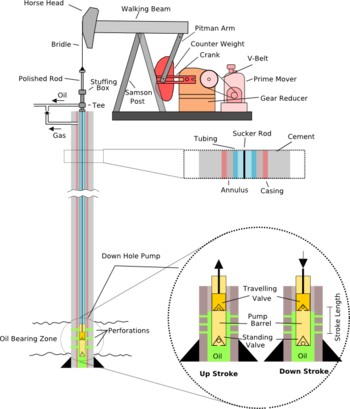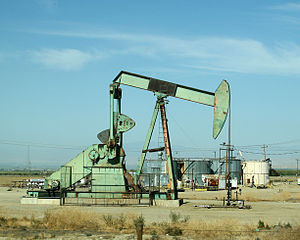- Pumpjack
-
"Nodding donkey" redirects here. For the British Rail train, see Pacer (train)."Pump jack" redirects here. For the Scaffold, see Pump-jack.
A pumpjack (nodding donkey, pumping unit, horsehead pump, beam pump, sucker rod pump (SRP), grasshopper pump, thirsty bird, jack pump) is the overground drive for a reciprocating piston pump in an oil well.
It is used to mechanically lift liquid out of the well if there is not enough bottom hole pressure for the liquid to flow all the way to the surface. The arrangement is commonly used for onshore wells producing little oil. Pumpjacks are common in oil-rich areas.
Depending on the size of the pump, it generally produces 5 to 40 litres of liquid at each stroke. Often this is an emulsion of crude oil and water. Pump size is also determined by the depth and weight of the oil to remove, with deeper extraction requiring more power to move the heavier lengths of sucker rods.
A pumpjack converts the rotary mechanism of the motor to a vertical reciprocating motion to drive the pump shaft, and is exhibited in the characteristic nodding motion. The engineering term for this type of mechanism is a walking beam. It was often employed in stationary and marine steam engine designs in the 18th and 19th centuries.
Contents
Above ground
In the early days, pumpjacks were actuated by rod lines running horizontally above the ground to an eccentric wheel in a mechanism known as a Central Power.[1] The Central Power itself, which might operate a dozen or more pumpjacks, was powered by a steam or internal combustion engine or by an electric motor. Among the difficulties with this scheme was keeping the system balanced as individual well loads changed.
Modern pumpjacks are powered by a prime mover. This is commonly an electric motor, but combustion engines are used in isolated locations without economic access to electricity. Common off-grid pumpjack engines run on casing gas produced from the well, but pumpjacks have been run on many types of fuel, such as propane and diesel. In harsh climates such motors and engines may be housed inside a shack to protect them from the elements.
The prime mover of the pumpjack runs a set of pulleys to the transmission which in turn drives a pair of cranks, generally with counterweights on them to assist the motor in lifting the heavy string of rods. The cranks in turn raise and lower one end of an I-beam which is free to move on an A-frame. On the other end of the beam, there is a curved metal box called a Horse Head or Donkeys Head, named so due to its appearance. A cable made of steel (or, occasionally, fiberglass) called a bridle, connects the horse head to the polished rod, a piston that passes through the stuffing box. The polished rod has a close fit to the stuffing box, letting it move in and out of the tubing without fluid escaping. (The tubing is a pipe that runs to the bottom of the well through which the liquid is produced.) The bridle follows the curve of the horse head as it lowers and raises to create an almost completely vertical stroke. The polished rod is connected to a long string of rods called sucker rods, which run through the tubing all the way to the down-hole pump, usually positioned near the bottom of the well.
Down-hole
At the bottom of the tubing is the down-hole pump. This pump has two ball check valves: a stationary valve at bottom called the standing valve, and a valve on the piston connected to the bottom of the sucker rods that travels up and down as the rods reciprocate, known as the traveling valve. Reservoir fluid enters from the formation into the bottom of the borehole through perforations that have been made through the casing and cement (the casing is a larger metal pipe that runs the length of the well, which has cement placed between it and the earth; the tubing, pump and sucker rods are all inside the casing). When the rods at the pump end are traveling up, the traveling valve is closed and the standing valve is open (due to the drop in pressure in the pump barrel). Consequently, the pump barrel fills with the fluid from the formation as the traveling piston lifts the previous contents of the barrel upwards. When the rods begin pushing down, the traveling valve opens and the standing valve closes (due to an increase in pressure in the pump barrel). The traveling valve drops through the fluid in the barrel (which had been sucked in during the upstroke). The piston then reaches the end of its stroke and begins its path upwards again, repeating the process.
Often, gas is produced through the same perforations as the oil. This can be problematic if gas enters the pump, because it can result in what is known as gas locking, where insufficient pressure builds up in the pump barrel to open the valves (due to compression of the gas) and little or nothing is pumped. To preclude this, the inlet for the pump can be placed below the perforations. As the gas-laden fluid enters the well bore through the perforations, the gas bubbles up the annulus (the space between the casing and the tubing) while the liquid moves down to the standing valve inlet. Once at the surface, the gas is collected through piping connected to the annulus.
Water well pumpjacks
Pumpjacks can also be used to drive what would now be considered old-fashioned hand-pumped water wells. The scale of the technology is smaller than for an oil well, and can typically fit on top of an existing hand-pumped well head. The technology is simple, typically using a parallel-bar double-cam lift driven from a very low horsepower electric motor.
Although the flow rate for a water well pumpjack is low compared to a jet pump and the lifted water is not pressurized, the water well pumpjack has the option of hand pumping in an emergency, by hand-rotating the pumpjack cam to its lowest position, and attaching a manual handle to the top of the wellhead rod.
Gallery
-
A nodding donkey-type pumpjack (painted to resemble a toucan) in the United States
-
Animation of a pumpjack in southern Alberta operating on natural gas. Location: 4-31-5-4 W4M
-
A field of pumpjacks along Interstate 20 in Texas
-
There are hundreds of pumpjacks on Lost Hills Oil Field near route 46 in California.
-
A pumpjack on display in New Mexico.
See also
References
External links
- All Pumped Up : Evolution of Oilfield Technology, The American Oil & Gas Historical Society, Vol. 3, No. 3, September 2006
Categories:- Pumps
- Petroleum technology
-
Wikimedia Foundation. 2010.








